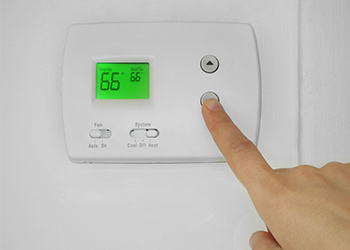In winter, the lower the temperature inside your home, the slower the loss of heat. So, the longer you keep your thermostat at the lower temperature, the more money you save because your home has lost less energy than it would have at a higher indoor temperature. You should also consider other things such as space heaters, water usage, insulation, etc.
Here are 10 helpful tips to help you conserve energy this winter:
1) Install a programmable thermostat so you can lower the temperature in your home when you aren't there and at night when you're sleeping.
2) Replace incandescent light bulbs with LEDs, which use at least 75 percent less energy.
3) Wash clothes in cold water, and use cold-water detergent when possible.
4) Open blinds and curtains during the day to allow sunlight in to warm your home. Close them at night.
5) Turn off lights when not in use.
6) Switch your ceiling fan blade rotation. Hot air rises, so this will help push the warmth back down to you.
7) Lower your water heater temperature. Use the warm setting (120 degrees) during fall and winter months.
8) Unplug electronics like kitchen appliances and TVs when you’re away.
9) Use power strips for multiple appliances, and turn on the main switch when you’re away from home.
10) Seal air leaks and insulate well to prevent heat from escaping and cold air from entering your home.
Do a DIY Home Energy Saving Inspection
First, make a list of obvious air leaks (drafts). The potential energy savings from reducing drafts in a home may range from 10% to 20% per year, and the home is generally much more comfortable afterward.
Check for indoor air leaks, such as gaps along the baseboard or edge of the flooring and at junctures of the walls and ceiling. Also check for leaks on the outside of your home, especially in areas where two different building materials meet. Other places to check for leaks include windows, doors, lighting and plumbing fixtures, switches, and electrical outlets. Also check for open fireplace dampers.
Seal Air Leaks
You should plug and caulk holes or penetrations for faucets, pipes, electric outlets, and wiring. Look for cracks and holes in the mortar, foundation, and siding, and look for leaks around windows and doors. Seal them with the appropriate material, such as caulk and weatherstripping.
Consider Ventilation
When sealing any home, you must always be aware of the danger of indoor air pollution and combustion appliance "backdrafts." Backdrafting is when the various combustion appliances and exhaust fans in the home compete for air. An exhaust fan may pull the combustion gases back into the living space. This can obviously create a very dangerous and unhealthy situation in the home.
In homes where a fuel is burned (i.e., natural gas, fuel oil, propane, or wood) for heating, be certain the appliance has an adequate air supply. Generally, one square inch of vent opening is required for each 1,000 Btu of appliance input heat. Burn marks or soot around the appliance burner or at the vent collar, or visible smoke anywhere in the utility room while the appliance is operating, indicate poor draft. When in doubt, contact your local utility company, energy professional, or ventilation contractor. Learn more about proper ventilation.
Check Insulation
Heat loss through the ceiling and walls in your home could be very large if the insulation levels are less than the recommended minimum. When your house was built, the builder likely installed the amount of insulation recommended at that time. Given today's energy prices (and future prices that will probably be higher), the level of insulation might be inadequate, especially if you have an older home.
If the attic hatch is located above a conditioned space, check to see if it is at least as heavily insulated as the attic, is weather stripped, and closes tightly. In the attic, determine whether openings for items such as pipes, ductwork, and chimneys are sealed. Seal any gaps with an expanding foam caulk or some other permanent sealant. When sealing gaps around chimneys or other heat producing devices, be sure to use a non-combustible sealant.
While you are inspecting the attic, check to see if there is a vapor barrier under the attic insulation. The vapor barrier might be tarpaper, Kraft paper attached to fiberglass batts, or a plastic sheet. If there does not appear to be a vapor barrier, you might consider painting the interior ceilings with vapor barrier paint. This reduces the amount of water vapor that can pass through the ceiling. Large amounts of moisture can reduce the effectiveness of insulation and promote structural damage.
Make sure that the attic vents are not blocked by insulation. You also should seal any electrical boxes in the ceiling with flexible caulk (from the living room side or attic side) and cover the entire attic floor with at least the current recommended amount of insulation.
Checking a wall's insulation level is more difficult. Select an exterior wall and turn off the circuit breaker or unscrew the fuse for any outlets in the wall. Be sure to test the outlets to make certain that they are not "hot." Check the outlet by plugging in a functioning lamp or portable radio. Once you are sure your outlets are not getting any electricity, remove the cover plate from one of the outlets and gently probe into the wall with a thin, long stick or screwdriver. A plastic crochet hook is particularly suited, as it will retrieve small bits of any insulation material for easy identification. If you encounter a slight resistance, you have some insulation there. You could also make a small hole in a closet, behind a couch, or in some other unobtrusive place to see what, if anything, the wall cavity is filled with. Ideally, the wall cavity should be totally filled with some form of insulation material.
If your basement or crawlspace is unconditioned and open to the exterior, determine whether there is insulation under the living area flooring. In most areas of the country, an R-value of 25 is the recommended minimum level of insulation. If the sub-space is enclosed and contains heating or cooling appliances, air ducts or plumbing, you should probably insulate the sub-space perimeter rather than the living space floor. The insulation at the top of the foundation wall and first floor perimeter should have an R-value of 19 or greater. If the basement is intentionally conditioned, the foundation walls should also be insulated to at least R-19. Your water heater, hot water pipes, and furnace ducts should all be insulated.
Inspect Heating Equipment
Inspect your heating equipment annually, or as recommended by the manufacturer. If you have a forced-air furnace, check your filters and replace them as needed. Generally, you should change them about once every month or two, especially during periods of high usage. Have a professional check and clean your equipment once a year.
If the unit is more than 15 years old, you should consider replacing your system with one of the newer, energy-efficient units. A new unit would greatly reduce your energy consumption, especially if the existing equipment is in poor condition. Check your ductwork for dirt streaks, especially near seams. These indicate air leaks, and they should be sealed with a duct mastic. Insulate any ducts or pipes that travel through unheated spaces. An insulation R-Value of 6 is the recommended minimum.

